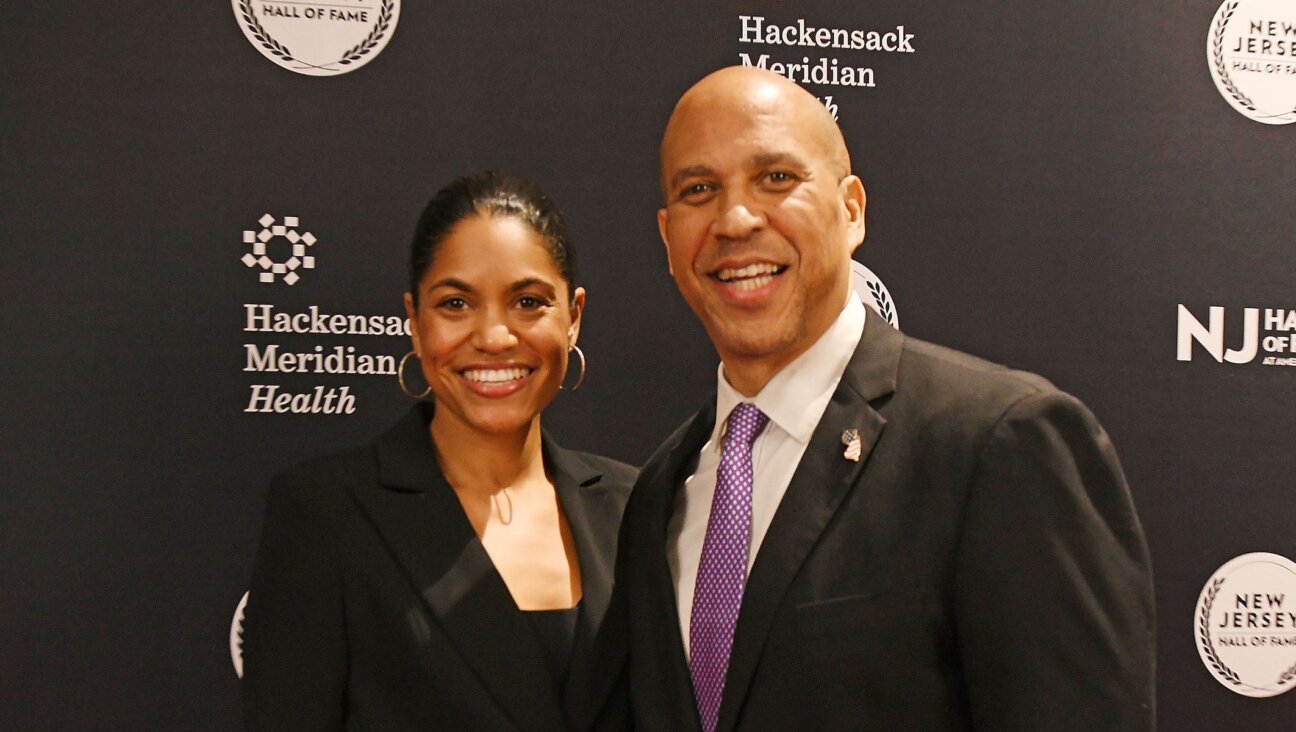How Jewish College Uses Federal Funds To Grow

Campus: Dov Stein, head of academics at Michigan Jewish Institute, stands outside the entrance to The Shul, a $6 million synagogue in West Bloomfield, where some MJI classes are held. Image by Paul Berger
It was the first week of the new semester at Michigan Jewish Institute, a college of more than 2,000 students, nestled in the leafy Detroit suburb of West Bloomfield. But at 3 p.m. on Wednesday, the classrooms were silent and the entrance to the college’s temporary home, an impressive $6 million brick-and-glass synagogue with a vaulted roof that soars 50 feet into the sky, was desolate.
That’s because in less than a decade, MJI has transformed itself from a small campus-based college into a burgeoning online university, thanks in large part to more than $25 million in federal aid, designated for low-income students, which the not-for-profit school has received over the past five years.
But very little of this money has been spent on men and women taking courses in Michigan or, indeed, in the United States. Instead, the majority of MJI’s students can be found working toward an MJI degree in Judaic studies at yeshivas and seminaries overseas, mostly in Israel.
In a September 13 interview in a classroom at MJI, which is based at a magnificent Chabad synagogue called The Shul, Dov Stein, director of academic administration, said that MJI’s enrollment had grown this year to 3,000 students from only 300 students in 2004. In a subsequent email, Stein revised the figure down to just over 2,000 students.
As MJI has expanded rapidly, it has drawn increasingly on the Federal Pell Grant Program, the government’s largest education aid program targeting low-income students, which funnels public funds directly to the school. At the same time, MJI’s net income has soared. According to the institute’s most recent available tax records, between 2006 and 2010 inclusive, MJI’s net income increased to $850,000 from $89,000 — a staggering 860% five-year jump. The school ended 2010 with almost $3 million in assets. So far this calendar year, the school has received $8.7 million in federal aid.
But its academic record is poor. As the number of students has risen, performance on national proficiency exams has plummeted. Student retention has suffered, too. Data compiled by the U.S. Department of Education showed that only 9% of the students who began their studies in 2010 as freshmen returned in 2011 as sophomores. According to the same data, MJI awarded only three bachelor’s degrees in 2011.
This, despite MJI’s best efforts to help students complete their studies quickly by taking classes online while simultaneously learning at Israel-based yeshivas, from which they also earn credit.
At a time when studies show the poverty rate growing among America’s ultra-Orthodox communities, MJI’s potential impact on its target audience — young Jewish men and women, many from religiously observant homes — could be profound. But school officials could provide little evidence that MJI’s graduates are finding jobs or going on to receive higher degrees.
Nonetheless, Stein insisted that MJI is positioned to grow larger still. “We could easily surpass 10,000 students actively pursuing a degree,” he said.
Thanks, in large measure, to the American taxpayer.
Michigan Jewish Institute was founded by Chabad-Lubavitch of Michigan in 1994 as a college catering mainly to Russian-speaking immigrants who needed to convert Soviet university degrees into something more recognizable to American employers.
Its first president was an Englishman, Chaim Dovid Kagan, who has five degrees, including a doctorate in physics from Imperial College, London. At the time, MJI offered vocational degrees specializing in business and computers. Yet even during the mid to late 1990s, some of MJI’s students enrolled in year-abroad programs.
Kagan, who left MJI in 2003, said many of those students used their affiliation with MJI to get financial aid for their year abroad and then did not return to MJI to complete their studies. As the number of overseas students rose, the college’s retention rate grew worse. “I knew a lot of people were only doing this [enrolling in MJI while abroad] to get the [financial] help and therefore there was a retention issue,” Kagan said. “It was inevitable that a lot of people would drop out.”
Kagan stressed that from the outset, MJI’s emphasis was on providing a “means and a Jewish environment to give job training, hence degrees in bachelors of applied sciences and in computing and business.” Study abroad was a side issue, so Kagan limited the number of year-abroad students to 120. “Otherwise,” he said, “retention would have been killed.”
But the number of Soviet Jews who needed job skills dwindled, as did the Jewish population in and around Detroit. “You are fishing in a very small pool,” said Hershel Gardin, MJI’s dean from 2000 until his retirement last year.
Gardin is an avuncular non-Hasidic Jew whose enthusiasm for MJI is infectious. Sitting in Sara’s Deli, a no-frills cafe in the Jewish Community Center at Oak Park, near his home in the heavily Orthodox neighborhood, Gardin explained the ultra-Orthodox dilemma — and how he believed MJI could help.
Too many young men and women are raised in families where secular and post high school education is frowned upon, Gardin said. And too many of those young people leave yeshiva and seminary without the qualifications necessary to provide for their large families. “They are a drag on the Jewish community,” Gardin said. “I am getting 15 letters a day, appealing for money for destitute people.”
Gardin believed that he had found a solution when, soon after joining MJI, he read of a communal study that warned of a dearth of talent in the organized Jewish world and in Jewish education. Potential employees either had excellent qualifications and a shallow understanding of Jewish life, or were knowledgeable about Judaism but lacked formal educational or managerial training.
Gardin thought he could design courses that would cover both areas, and thereby train a new generation of Orthodox Jews who could fan out to Jewish homes for the aged, hospices, schools and after-school programs, and fill gaps in federations. “We can make them upwardly mobile,” Gardin said. MJI’s degree in Judaic studies was born.
But Gardin had to get his program to people. “Online is the way to my world,” Gardin said. “It is my marketplace.”
In order to be able to offer degree courses and to be eligible for federal funding, a college must be accredited by one of several government-recognized accreditation agencies. MJI was first approved by the Accrediting Council for Independent Colleges and Schools in the late 1990s under Kagan. It has managed to pass every subsequent accreditation, carried out every two to six years since.The school’s next accreditation review is set for 2013.
Anthony Bieda, ACICS spokesman, said the agency does not accredit religious colleges or universities. “We accredit career colleges,” Bieda said, “and that scope is derived from U.S. Department of Education regulations and federal statute.”
In 2008, ACICS gave MJI permission to launch its online degree program in Judaic studies, which allowed MJI to increase student enrollment and to grow its study abroad programs. That same year, federal student aid to MJI began its rapid rise.
The men’s campus of Mayanot Institute of Jewish Studies, a Chabad yeshiva, can be found on a busy street in a devout Orthodox neighborhood near Mahane Yehuda market, in West Jerusalem.
One recent Monday afternoon, a large group of men sat around a long table in an outdoor courtyard, studying. “This is absolutely a yeshiva environment,” said Jitschak Rosenbloom, Mayanot’s director of operations, speaking from a basement office below a beit midrash — or house of study — crammed with volumes of Talmud and other religious books, fronted by a Holy Ark.
Mayanot’s website reassures prospective students that a “lack of finances is not an obstacle” to an education at Mayanot. In addition to grants and scholarships from Jewish institutions such as local American federations, Taglit-Birthright Israel and MASA (a program of the Jewish Agency for Israel and the Israeli government), Mayanot directs prospective American students to the U.S. Department of Education’s Pell Grant program.
It’s not unusual for foreign institutions to accept American students who are funded partly by Pell grants and come to study in a year-abroad program. Many overseas schools and colleges operate such programs. But in this case, Mayanot’s website appears to be directly recruiting students by suggesting they apply for Pell grant aid so that they can attend Mayanot in Israel as their primary institution.
Pell grants were introduced 40 years ago to help low-income students go to college. Despite the recent financial crisis and congressional attempts to curb spending, the Obama administration has increased Pell spending to $35.7 billion this year, from $18.3 billion in 2008. The maximum Pell award for a student this year was $5,550.
Although the program has succeeded in sending a growing number of young people to college, some foundations, policymakers and analysts believe it should focus more on college completion rates than simply on access to college. This concern has been exacerbated by reports that some for-profit universities are making huge sums from federal aid while shepherding very few students through to the end of their certificate program or degree.

Class Schedule: A list of classes offered at MJI. Image by Paul Berger
In order to be eligible for a Pell grant to attend the yeshiva, Mayanot’s young men and women must register as students at MJI — something that has become much easier since the expansion of the college’s online program, which allows students to be based anywhere in the world.
Stein said that more than 80% of MJI’s students are enrolled in its online courses. Some of those students are taking a purely online degree: Stein put the number this year at 150 to 200. But the rest combine online classes with study abroad in places such as Mayanot.
During Stein’s first interview with the Forward, on September 13, he said he could not recall the names of any of the 60-or-so host schools MJI worked with in the past academic year, though he said Jerusalem was a popular location. He also could not say which was the most popular school.
In a September 24 email, Stein named three highly regarded Jerusalem seminaries and one yeshiva as “among the most popular” schools for the coming year — Beth Jacob Teachers Seminary, Seminary Beit Yaakov Darchei Rachel, P’ninim Seminary and Yeshivas Tiferes Yerushalayim. But a page on MJI’s own website lists some 45 institutions, including 40 in Israel, almost all of them yeshivas for men or religious seminaries for women.
Stein said he could not offer student numbers for each school because enrollment for MJI’s study abroad students would not be finalized until the end of the Jewish holidays, on October 9.
Rivka Preisler, Mayanot’s financial aid officer and finance manager, said that about 15 to 20 of the institute’s 120 students are on an MJI study abroad program partly funded by Pell grants. Preisler said MJI takes “a certain amount” of the Pell grant and the rest is “applied to Mayanot tuition.”
Kasriel Shemtov, MJI’s president, told the Forward in a September 30 email that “MJI students who are resident U.S. citizens currently are charged a fixed administrative fee of $2,650 in addition to the host school tuition.”
Although MJI still offers vocational degrees geared toward information technology and business, its most popular degree by far is Judaic Studies. Last year, according to an MJI document, a total of 167 MJI students were enrolled in business or computer programs, compared with 1,728 students enrolled in the Judaic studies degree.
Stein said the Bachelor of Arts in Judaic Studies is a four-year course, but students who study abroad can complete it faster by taking MJI online classes concurrently with their Israel-based studies in yeshiva.
MJI students need 120 credits for a bachelor’s degree. But Stein said that if students study overseas they can accrue 24 credits at a yeshiva or a seminary and a further 24 credits at MJI online in the same year. “We don’t typically recommend it, because the heavier the [work]load, the less likely you are to succeed in your studies,” Stein said. “But yeah, theoretically, you could accumulate” up to 48 credits in one academic year. Many students finish their first year with “between 40 and 48 credits,” he said.
Working at such a pace, it could take an MJI student as little as two and a half years to complete his or her degree — especially if a student transfers in credit from a yeshiva or from work experience prior to starting the degree, a practice that is popular among MJI students.
According to Mayanot’s website, students can receive a bachelor’s degree in just two years at the school “in addition to two semesters of general studies” at MJI online.
College Navigator, which uses data compiled by the U.S. Department of Education, reports that only 9% of MJI’s freshmen students who began their studies in 2010 returned in 2011 for a second year. MJI claims its retention rate is closer to 97%.
The disparity is caused by the radically different ways in which MJI and the Department of Education count their students.
MJI bases its retention rate not on students who return the following year, but on how many students complete the academic year they are in. MJI’s Stein said that is how “retention” is defined by MJI’s accreditor, ACICS.
Bieda agreed that his agency does count retention in this manner. But he explained that ACICS focuses on retention during a single academic year because it specializes in accrediting career colleges, many of which run 12- to 18-month diploma and certificate programs rather than four-year degree programs. “For simplicity’s sake we stick with the one-year cohort of retention,” Bieda said.
The Forward asked Stein on September 28 to provide retention numbers from the most recently available group of freshman who went on to sophomore year. Stein did not respond. The Forward asked Shemtov the same question on September 30 and again on October 2. Shemtov said that MJI “would have to look into the meaningfulness of such a number at a future date.”
However, figures published in MJI’s most recent Institutional Effectiveness Plan, an internal document produced as part of MJI’s accreditation procedure, show a steep fall-off in student numbers from one year to the next. At the end of the academic year 2011–12, MJI had 1,522 freshmen, 320 sophomores, 51 juniors and 26 seniors.
When asked about these figures, Stein said they reflected MJI’s rapidly increasing enrollment.
Although MJI’s website refers to its “main campus library,” the college has never had a permanent home. Currently, it uses classroom space in The Shul, a modern 20,000-square-foot synagogue that opened in West Bloomfield in 2002
One midweek evening in September, a couple dozen students, mainly high school girls, were spread over three classrooms. Most looked to be very secular — short shorts, exposed elbows — taking basic Hebrew lessons they could use as dual enrollment credits that count toward the foreign language requirement for their high school or college.
There was a stark contrast between these girls and many of MJI’s graduates who study abroad. A few years ago, MJI instituted a standardized exit exam to gauge the proficiency of its students in writing, math, reading and critical thinking. Results published in MJI’s Institutional Effectiveness Plan show that as MJI’s student body grew, the exam results deteriorated sharply.
Between 2008 and 2011, national percentile rankings for MJI students fell across the board. Writing proficiency fell to 32% from 61%, reading fell to 30% from 55%, math fell to 28% from 42% and critical thinking fell to 25% from 73%.
Stein said that the results worried MJI. One possible reason for the decline, he said, was that many students may not have English as a first language and are more proficient in Yiddish and Hebrew, so a timed test in English “is not a representative measure of their abilities.”
This year, Stein said, MJI put its students through a similar exit exam, this time in Hebrew, “and results improved.”
During their interviews, Stein and Gardin spoke proudly of MJI graduates who had used their degree to go on to higher education. Stein said one student had gone to Yeshiva University and another to Columbia University.
Elizabeth Stein, investigative counsel for the U.S. Senate committee looking into the use of Pell grants, was skeptical. A public or a not-for-profit university, she said, would be unlikely to accept transfer credits from an institution accredited, as MJI is, by ACICS. According to Elizabeth Stein, most public and not-for-profit universities look for regional accreditation before accepting credits from another school. ACICS is a national accrediting agency.
MJI’s president Shemtov said “simply this is wrong.” Shemtov added that MJI graduates “have been accepted by numerous graduate and professional schools,” such as Duke University, Rutgers University and Temple University.
The Forward asked to speak to the MJI graduate who went to Columbia or to other alumni who had secured a job or were accepted to graduate school. MJI put the Forward in touch with Shalom Stark, an American living near Caesarea in Israel. Stark completed two B.A.s at MJI online — in Judaic studies and in business information systems — in two years. He was able to do so quickly because he transferred in credits from his community college and from time at a yeshiva.
Stark said that Bar-Ilan University accepted him in its Master of Business Administration program but a business he started — Shalom Israel Tours — was doing so well that he did not have time to study further.
In addition to being president of MJI, Shemtov is the spiritual director of The Shul, where MJI is temporarily based. (Mayanot’s executive director is also named Kasriel Shemtov. MJI’s president declined to say whether they are related.)
The Shemtovs are a powerful and influential family within the Chabad-Lubavitch movement. The Shemtov dynasty in Michigan was launched in 1958, when Kasriel Shemtov’s father, Berel Shemtov, founded Chabad of Michigan. Berel Shemtov and his children founded several congregations and institutions. In 1990, Chabad of Michigan bought 40 acres of former forestland in West Bloomfield, known as the Campus of Living Judaism.
The Shul sits at the heart of the campus. A couple of minutes’ walk north is The Friendship Circle, a hugely successful not-for-profit serving children with special needs that was founded by Kasriel Shemtov’s sister Bassie and her husband, Levi Shemtov (Kasriel Shemtov declined to say whether Levi is a direct relation).
During the Forward’s visit to the Campus of Living Judaism, both Dov Stein and Levi Shemtov pointed out a plot of forested land, between The Shul and the Friendship Circle, that has been set aside for a new multimillion-dollar permanent building for Michigan Jewish Institute — a school where most of the students do not speak English as a first language and where most of the students can be found online or overseas.
Contact Paul Berger at [email protected] or on Twitter@pdberger
Ben Lynfield contributed to this story from Jerusalem.

















